Nikon D50 review with 18-55mm f3.5~5.6 DX lens
-
-
Written by Gordon Laing
In depth
Pictured below from left to right are the Canon EOS-350D, Konica Minolta Dynax 5D, Nikon D50 and Pentax *istDL. Available in black or silver, the Nikon D50 looks and feels like a smart and serious piece of kit which won’t let you down. At first glance it resembles the D70(s), but place the two side by side and there are obvious differences. Most obviously the D50’s smaller at 133x102x76mm and lighter too at 830g including kit lens and battery, although it remains noticeably larger and heavier than most of its budget competition.

While Canon and Pentax fight over who can lay claim to having the smallest digital SLR though, some photographers feel both companies have gone too far and produced bodies which compromise comfort and ergonomics. In contrast, the larger D50 enjoys a decent-sized grip which better suits those with bigger hands. Of course the ideal size, shape and weight of a camera is highly subjective and you’ve really got to pick up and feel each to see which suits you best. One thing’s for certain though: despite its budget price, the D50’s build quality feels superior to its rivals.
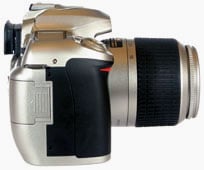
The D50’s powered by a single 1400mAh Lithium Ion battery pack and is supplied with a mains recharger. Nikon claims each charge is sufficient for up to 2000 shots under typical shooting and playback conditions. Certainly during our extended testing period we’ve only had to recharge the battery once.
Like the D70(s), the D50’s top surface is divided between the main control dial on the left and a large (non-backlit) screen on the right showing shooting information. The D50’s control dial features the usual Auto, Program, Manual, Shutter and Aperture Priority modes, along with six scene presets including the new Child mode boasting vivid colour but natural skin tones. Shutter speeds range from 1/4000 to 30 seconds plus Bulb in half or third stop increments. Exposure compensation is offered in a very wide range of +/-5EV again in half or third stop increments.
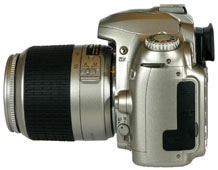
The position and operation of the controls is generally well thought-out. ISO, white balance and quality settings can be quickly adjusted by holding the required button on the back and turning the thumb wheel as you watch the status screen. The menus on the main colour screen are also crisp and clear, although the magnification in playback mode is a little convoluted: you first have to press the magnifying button, before holding another as you turn the thumb dial to draw a marquee. You can then use the four-way control pad to move around the image, but again need to redefine the marquee area if you want to adjust the magnification. Surely it’d be easier to just have one button to zoom-in and another to zoom-out again.
There’s a popup flash and i-TTL flash control at fast synchronisation speeds of up to 1/500 second. You can select front or rear curtain, red-eye reduction, slow sync or slow sync with red-eye. There’s also flash compensation from -3 to +1EV.
Composition and screen
The D50’s viewfinder focussing screen is clear and unlike the D70(s) features two new icons in the lower left corner to indicate low battery or the absence of a memory card. Sadly the on-demand grid lines of the D70(s) focussing screen though are not present on the D50. This grid, which can be switched on and off on the D70(s), greatly aids composition and would have given the D50 a neat advantage over its budget rivals. Like its immediate competition, the D50 employs a penta-mirror to reduce cost (and weight), but the view remains bright.
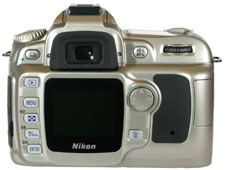
Nikon’s fitted a new 2in LCD screen on both the D50 and D70s with 130,000 pixels. This is the same resolution as the 1.8in screen of the D70, but carries sufficient detail to still look sharp at this slightly larger size. Images and menus look bright and colourful, and while it’s not as impressive as the 2.5in 210,000 pixel screen of the Pentax *istDL, it’s a step up in size from that on the Canon EOS-350D and in perceived detail from the Konica Minolta 5D’s large but coarse display.
New to the D50 is improved auto-focus including an automatic mode which can switch between AF-S (single servo autofocus) and AF-C (continuous servo autofocus), depending on the motion and tracking of the subject in question.
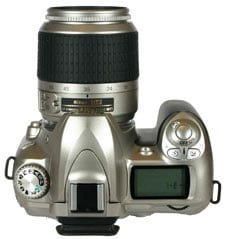
Lens
The D50 is equipped with an Nikon F-mount and its sensor size results in all lenses having their focal length effectively multiplied by 1.5 times. The D50 is compatible with all DX Nikkor lenses and type G or D AF Nikkor lenses with all functions supported. Other AF Nikkor lenses can be used with all functions supported apart from 3D Colour Matrix Metering II, i-TTL Balanced fill-flash. Older or specialist Nikkor lenses have further restrictions listed on Nikon’s website.
The D50 was launched with two new AF-S Nikkor DX lenses designed for its smaller sensor size: the 18-55mm f3.5~5.6 and 55-200mm f4.0~5.6. Both lenses employ Nikon’s Silent Wave Motor, SWM technology which allows fast, quiet focussing and are available in black or silver.
The 18-55mm lens is optionally available as a bundle with the D50 and delivers an equivalent focal length of 27-82.5mm. It may be a light budget model, but can perform well, especially when stopped down a little – see our results page. The SWM focussing motor is also slightly faster and quieter in operation to the 18-55mm EF-S lens bundled with Canon’s EOS-350D, although both lenses employ rotating front elements which are inconvenient for users of polarising filters.
Nikon D50 sensor
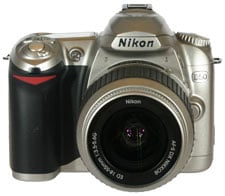 The D50 employs the same 6.1 Megapixel CCD sensor of the D70(s), which measures 23.7 x 15.6mm (DX format) and delivers images with 3008 x 2000 pixels. The DX format sensor results in all lenses effectively having their focal length multiplied by 1.5 times. The sensitivity can be set between 200 and 1600 ISO in 1EV steps.
The D50 employs the same 6.1 Megapixel CCD sensor of the D70(s), which measures 23.7 x 15.6mm (DX format) and delivers images with 3008 x 2000 pixels. The DX format sensor results in all lenses effectively having their focal length multiplied by 1.5 times. The sensitivity can be set between 200 and 1600 ISO in 1EV steps.
Files and memory
Images can be recorded at three different resolutions, each with a choice of three JPEG compression levels. They can also be recorded in Nikon’s RAW NEF format with the option of an accompanying JPEG if desired, although only at basic quality. Using the full resolution and best-quality JPEG setting, our test images measured between 2 and 3.2MB, although the vast majority worked out around 2.9MB each. Adobe RGB and sRGB colour spaces are supported, along with a tweaked default sRGB option for more vibrant landscapes.
The D50’s supplied with basic software which can convert RAW files, but the powerful and preferred Nikon Capture package is only offered as a trial; this seems a little mean considering Canon supplies all it’s DSLRs with its high-end RAW conversion package.
The D50 follows in Pentax’s footsteps by abandoning Compact Flash memory cards in favour of the smaller SD format, although unlike the *istDS and DL, this clearly wasn’t to implement a smaller body. When Pentax first implemented SD on a digital SLR it seemed almost blasphemous, but now with large, fast and affordable SD cards available, it’s no longer a big deal. The camera employs a USB-2.0 port for transferring images.
Image processing and handling
With the earlier D70, Nikon took the lead in quick startup times, and thankfully nothing’s changed here. The D50 powers up in 0.2 seconds which is to all intents and purposes instantaneous. The same speed applies to waking up from power-saving sleep mode or from playing back images when you half-press the shutter release button. In short, the D50 will be ready for action when you are.
The D50 has a continuous shooting speed of 2.5fps at its best quality JPEG setting. This is a tad slower than the 3fps of the D70(s) and the EOS-350D, but on the plus side there’s absolutely no concerns over buffer or flush times. Using a budget Kodak SD memory card, we held down the D50’s shutter release button and it dutifully continued to fire at close to its full speed until we gave up counting at over 100 shots. The camera then took 68 seconds to record all this data to the card, or about 0.7 seconds per image.
Images are displayed in playback very quickly, with single frames appearing almost instantly and thumbnails of four or nine images loading in under a second. This is about twice as fast as Canon’s EOS-350D, although to be fair, the average file size of the 350D’s images was larger and it has faster continuous shooting.




